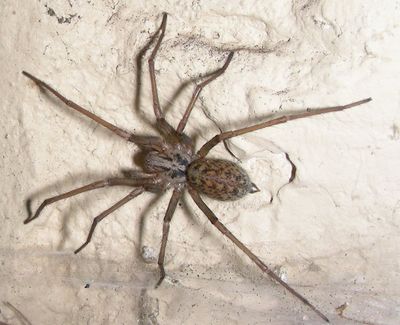Cool Critters: This eight-legged tenant is a do-gooder in your home

It’s hard being a spider, especially this time of year when fearmongering gets dialed up alongside zombies, ghouls and killer clowns.
But unlike Halloween décor, this particular spider lives and eats inside your home. And not just during autumn, mind you, but all year round.
Face your fears and meet your eight-legged housemate known as the giant house spider. Measuring as large as the palm of your hand, it may look intimidating while loitering in your bathtub or scuttling across the utility-room floor, when instead it is “docile, harmless and beneficial,” said Rod Crawford, arachnid curator at the Burke Museum of Natural History and Culture in Seattle.
What’s more, contrary to what many people believe, the critters don’t flee autumn’s cooler temperatures by sneaking inside, he explained. Instead, they’ve been inside all along – tucked away in a corner, behind an appliance, under a storage box – someplace dark and remote.
“Nearly all spider species live outdoors. The giant house spider is one of the few species that has evolved to live indoors,” Crawford said.
There’s a general assumption that giant house spiders enter homes in the fall because that’s when they’re most often seen by humans. In actuality, “people are seeing them because it’s mating season, when the spiders are most active indoors,” he said.
The males emerge from their secluded webs and go searching for a mate. All in the comfort of their human-made dwellings.
The giant house spider is a year-round tenant, which explains why “house” is part of its common name. The adult species’ impressive size explains the “giant” part. A body length of 1 inch and leg span of 4 inches makes it among the largest spider types in North America.
Perhaps “speed machine” should be tacked on to its name as well. The spider’s long, tentacle-like legs enable it to dart as fast as 1.5 feet per second across a hard surface, according to the Guinness Book of World Records, which ranked the giant house spider as the world’s fastest spider until 1987. (The species was far outranked by the desert-dwelling Moroccan flic-flac spider, which travels up to 6.5 feet per second.)
Native to Europe, the giant house spider made the voyage to North America about 100 years ago. The species was first documented in Spokane and Pullman in the 1990s and is one of the more common spiders across the Pacific Northwest, according to “Common Spiders of Washington,” published by Washington State University Extension.
Should you find one in your home, what should you do? Resist the urge to kill it, advised Crawford, who has studied spiders for 50 years. Besides posing no danger to you or your pets, there’s an upside to keeping it around.
“They eat household insects, including flies, fleas, cockroaches and ants,” he said. Basically, they provide chemical-free pest control.
If you still can’t bear the idea of the spider residing in your home, evicting it to the outdoors will “condemn it to a slow, lingering death,” Crawford said, adding that a better option is to relocate it to a man-made structure such as a garage, crawlspace or toolshed.
Whether a giant house spider is lodged in a corner behind your lawn mower or underneath the clothes dryer, John Bankston, author of “All about American House Spiders,” puts it this way:
“Every day it attacks. Every day it kills. But it’s more afraid of you than you are of it.”